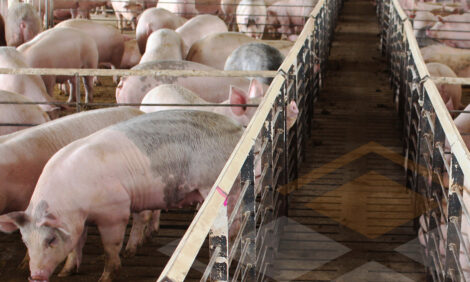



Alleviating PED with ADIMIX Precision
Porcine epidemic diarrhoea (PED), caused by a coronavirus, has been affecting pig production worldwide but butyrate may be a very valuable tool in the fight against the dramatic effects of PED on the infected pig, says Nutriad.During the last two years, a highly virulent strain of this virus has been associated with devastating outbreaks in the Americas and in Asia, and recent reports of PED cases in Ukraine have raised concerns about the threat of the highly virulent Asian-American strain in Europe.
Pigs are the only known hosts of the PED virus. The virus is shed in the faeces and is usually transmitted orally. Most commonly, the introduction of infected pigs into susceptible farms causes outbreaks of PED within four to five days but the virus may also be introduced into a susceptible herd through contaminated personnel, equipment and other fomites (Pospischil et al., 2002). Clinical signs of PED may vary widely and are dependent on previous exposure and the immunological and endemic status of the farm, region or area affected (Geiger & Connor, 2013).
When the virus is first introduced in a susceptible (i.e. naïve) population, there is a rapid spread of diarrhoea across all breeding and growing pigs with almost 100 per cent morbidity. Mortality in the young infected piglets approaches 100 per cent as they easily succumb from diarrhoea and consecutive dehydration. The main clinical signs in the other age groups are watery diarrhoea, vomiting, depression and loss of appetite.
The underlying cause for the clinical signs is that the virus replicates in enterocytes on villi of the small intestine and to a lesser degree in cryptal cells of both small intestine and colon. Viral replication subsequently causes degeneration and necrosis of enterocytes, resulting in loss of tissue fluid into the lumen and failure of the intestine to adequately absorb water. Diarrhoea follows and leads to dehydration.

Figure 1. Structure of Porcine Epidemic Diarrhea virus (PEDv) coronavirus. Source: http://humanviruses.org/tag/porcine-epidemic-diarrhea-virus/
Successful Trials with ADIMIX® Precision
Aside from strict biosecurity measures to avoid introduction of the virus and, in case of infection, supportive therapy to prevent dehydration (electrolytes, warmth) producers are looking for other options to strengthen the animal’s defence and to help the pigs dealing with the negative consequences from the disease.
Thanks to its specific effects on enteric development and intestinal health, butyrate is a suitable candidate. Several studies have indicated that besides providing epithelial cells with energy, butyrate markedly enhances proliferation, differentiation and maturation of enterocytes in the small intestine and improves colonic barrier function (Wang et al., 2005; Manzanilla et al., 2006; Sengupta et al., 2006). The protective and recovering effect of butyrate has been demonstrated in in vivo challenge trials with micro-organisms (E. coli in piglets and C. perfringens in poultry) damaging the intestinal barrier like PED virus does (Bosi et al., 2009; Timbermont et al., 2010).
Very recent research at the University of Taiwan looked into survival and performance of PED-infected newborn piglets. The trials were conducted on commercial farms, under supervision of the University of Taipei (Taiwan).
Twenty sows that were demonstrated to be PCR-positive for PEDv (rectal swab) and their litters, were selected for the trial. The sows were divided into 2 treatment groups: sows receiving no additional dietary supplementation (control group) and sows receiving 2kg er tonne ADIMIX Precision during the last three weeks of gestation and during lactation (ADIMIX group). The litters from these sows were also tested by PCR and a litter was considered PEDv-positive if at least one piglet out of two tested was PEDv-positive. Piglets from the control sows received no additional treatment and piglets from the ADIMIX sows received 2kg per tonne ADIMIX Precision in their liquid creep feed one week before and one week after weaning (weaning at day 21).
The following scheme gives a more visual representation of the supplementation scheme in the sows and piglets of the ADIMIX®-group:

Figure 2. Supplementation scheme in the ADIMIX-supplemented test group
During the trial, performance of both the sows and the piglets was evaluated for the control group in comparison with the ADIMIX-supplemented group.
Sows were individually weighed at three weeks before farrowing, at farrowing and at weaning. Results are depicted in the figure below, together with the results of the average number of piglets alive per sow and the percentage of still-born piglets per group.

Figure 3. Average sow weight and number of piglets born per group.
Average weight of the sows at the start of the trial was the very comparable. The results indicate that sows receiving ADIMIX Precision during gestation and lactation were heavier at farrowing and at weaning and produced more viable offspring than the control group. On average 34 per cent more live piglets were noted in the ADIMIX-supplemented group.
For the piglets, individual weight was determined at birth, at day 14, day 21 (weaning) and at the end of the trial at day 28. Furthermore, at weaning, mortality per cent per group was evaluated.

Figure 4. Average piglet weight over time and mortality percentage of piglets at weaning per group.
Results indicate that the ADIMIX supplementation has an even more pronounced effect on the piglets: piglets from the ADIMIX Precision group were statistically heavier from day 14 onwards, and at the same time PED-associated mortality measured at weaning dropped substantially. ADIMIX Precision supplementation resulted in a reduction of piglet mortality from 81 per cent to only 54 per cent.
These results demonstrate that, due to butyrate’s effect on intestinal tissue health and healing, ADIMIX Precision supplementation in PED affected piglets helps them to cope better with the infection.
Using the Right Product
Since the virus damages intestinal cells in the small intestine and in the colon, it is crucial that butyrate is able to reach these areas. Butyrate can only arrive in the lower luminal parts of the intestinal tract when it is protected from metabolisation in the stomach and is gradually released in the distal regions of the intestine. The most efficient way to achieve this is by administering a protected butyrate with precision delivery capacity such as ADIMIX Precision.

Figure 5. Matrix-encapsulated Na-butyrate (ADIMIX Precision) ensures precision delivery.
Different coated butyrate products are available for use in animal production. They come however in many different shapes and forms. One should make a clear distinction between high quality coatings that result in optimal protection and precision delivery of butyrate as opposed to coatings that are solely applied to cover the distinct butyrate smell.
In recent research done at the University of Illinois (Sotak et al., 2013) the importance of a high quality coating was demonstrated. Weanling pigs were randomly allotted to three dietary treatments (six replicate pigs per treatment), namely a control group (no butyrate supplementation), a group receiving 4kg per tonne of a smell coated butyrate (50 per cent Na-butyrate) and a group receiving 4kg per tonne of a precision-delivery butyrate (ADIMIX Precision, 30 per cent Na-butyrate).
Pigs were euthanized and the concentration of butyrate was analyzed in samples from different parts of the intestinal tract.
Weanling pigs fed ADIMIX Precision had significantly higher (P<0.05) concentrations of butyrate in the jejunum and ileum in comparison with both the control group and the group fed the smell coated butyrate.
It could therefore be concluded that administration of high quality protected butyrate (ADIMIX Precision), in spite of lower percentage of Na-butyrate (30 per cent), was effective in delivering butyrate to the lower intestinal tract of pigs, whereas supplementation of the more concentrated (50 per cent) but less protected butyrate (smell coated) was not.

Figure 6. Results of the butyrate recovery (butyrate/DM content) of 50 per cent smell coated butyrate and 30 per cent ADIMIX Precision in comparison with an unsupplemented control group.
The trials in Taiwan explained above were performed specifically with a high quality precision delivery product (ADIMIX Precision) because it is the only way to ensure delivery of butyrate to the lower parts of the intestinal tract, i.e. the area where the virus damages the intestinal cells and support is needed.
Nutriad says that the results from the Taiwanese study reflect the critical importance of a precision delivery coating. ADIMIX Precision will be superior in getting the most out of butyrate supplementation, both at the level of performance as on intestinal health.
Summary
In conclusion, thanks to its specific properties on intestinal health, butyrate may be a very valuable tool in the fight against the dramatic effects of PED on the infected pig.
However, to unlock the full potential of butyrate, it is crucial to assure its delivery in the right area.
When applying protected butyrates in animal production, it is of great importance to distinguish between different types of coated products, as their in-vivo efficacy will greatly differ due to their different delivery profile. These results demonstrate that ADIMIX Precision delivers butyrate to the areas most affected by PED.
References
- Bosi, P., S. Messori, et al. 2009. Effect of different butyrate supplementations on growth and health of weaning pigs challenged or not with E. coli K88. Ital. J. Anim. Sci. 8(Suppl. 2):268-270.
- Geiger, J.O. and J.F. Connor. 2013. Porcine Epidemic Diarrhea, Diagnosis, and Elimination. American Association of Swine Practitioners p1-4.
- Manzanilla, E.G. 2006. Effects of butyrate, avilamycin, and a plant extract combination on the intestinal equilibrium of early-weaned pigs. Journal of Animal Science. 84(10):2743-2751.
- Pospischil, A., A. Stuedli, et al. 2002. Update on porcine epidemic diarrhea. Journal of Swine Health and Production 10(2):81-85.
- Sengupta, S., J.G. Muir, et al. 2006. Does butyrate protect from colorectal cancer? Journal of Gastroenterology and Hepatology 21(1 Pt 2):209-218.
- Sotak, K., M. Song, et al. 2013. Disappearance of butyrate in the digestive tract of weanling and growing pigs fed diets containing different sources of butyrate. Journal of Animal Science 91(Suppl. 2):110.
- Timbermont, L., A. Lanckriet, et al. 2010. Control of Clostridium perfringens-induced necrotic enteritis in broilers by target-released butyric acid, fatty acids and essential oils." Avian Pathology. 39(2):117-121.
- Wang, J., C. Y., et al. 2005. Effect of sodium butyrate on the structure of the small intestine mucous epithelium of weaning piglets. Chinese Journal of Veterinary Science and Technology 35(4):298-301.
March 2015






